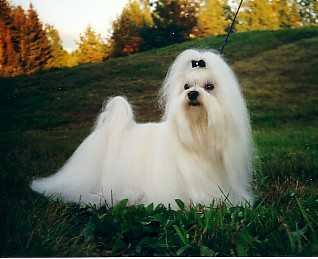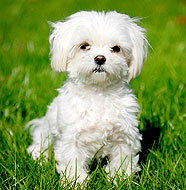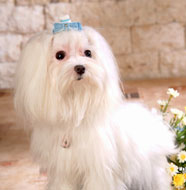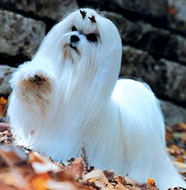| |
|
|
Maltese Information

Maltese Facts
| Size |
Small |
| Male Max Weight |
4-7 lb |
| Female Max Weight |
4-7 lb |
| Life Span |
12-14 years |
| Energy Level |
 |
| Ease of Training |
 |
| Grooming |
 |
| Shedding |

|
| Exercise Requirements |

|
| Playfulness |

|
| Affection Level |

|
| Good With Dogs |

|
| Good With Pets |

|
| Good With Strangers |

|
| Watchdog Ability |

|
| Protection Ability |

|
| Cold Tolerance |

|
| Heat Tolerance |

|
Maltese Temperament
|
The Maltese is considered by some to be the quintessential lap dog. It is
gentle, affectionate, and playful, enjoying high energy games in the house. The Maltese does
have a more scrupulous, confrontational side that, while not at all dangerous to others, may be
dangerous to itself when challenging larger dogs, which it is known to do. Keeping a close eye
on the Maltese when meeting unfamiliar dogs is, therefore, a prudent choice. Some Maltese bark
quite a bit, while others are more reserved and quiet. In general, they can feel threatened and
shy around
strangers.
|
Maltese Upkeep
|
The biggest concern with Maltese upkeep is its coat, which needs a lot of
attention and is easily dirtied. Maltese for shows can have their coats “wrapped”, thereby
protecting it from dirt and damage. Others may want to consider trimming their hair back
occasionally, as it will get dirty in certain climates. Their hair should also be combed at
least every other day, and preferably daily. Maltese require some exercise, but this is easily
met with daily light play indoors, a run in the yard, or a short
walk.
|
Maltese Health
|
The Maltese is generally a healthy breed. They have no major health concerns
that are common amongst most of them. Like many other smaller dog breeds, the Maltese can lose
its teeth at a relatively early age. Make sure to brush their teeth occasionally, especially
the gums, as this area is prone to infection. Maltese also have long hair that can irritate
their eyes, leading to problems down the road. This causes the tear glands to over produce,
resulting in tear stains on their coat. This area should be cleaned regularly, and become part
of daily maintenance. Also keep an eye out for excessive irritation, which can be symptomatic
of ulcers. A quick visit to the veterinarian will take care of this, but if left untreated can
cause serious eye damage. Be aware that Maltese are more susceptible to knee, eye, and thyroid
issues than most, so occasional check-ups at the vet can help mitigate these risks. Some of the
more minor issues with Maltese include: patellar luxation, open fontanel, hypoglycemia,
hydrophalus, distichiasis, entorpion, and portacaval shunt, although these are relatively
rare.
|
Maltese History
|
The Maltese is one of the oldest known dog breeds in the world. It originated
in Malta, with some of the earliest recordings being found in Greek writings from as far back
as 300 BC. The Maltese has always been exported to various parts of the world, but the majority
of them remained in Malta, which accounts for its ability to remain such a pure breed. Around
the 1300’s, the Maltese was introduced to England and quickly became the most popular breed
with those of the upper-class, who loved their gorgeous coat and small size. Later, the Maltese
is thought to have been threatened almost to the point of extinction. They later bounced back,
and they were introduced into the AKC in 1877.
|
Maltese Pictures
|
Puppies

Middle Aged

Older

|
Maltese Videos
|
|
|








